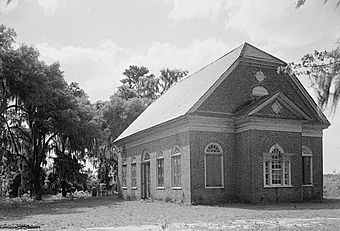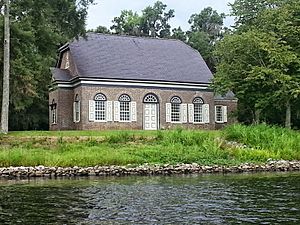Pompion Hill Chapel facts for kids
|
Pompion Hill Chapel
|
|

Pompion Hill Chapel
|
|
| Location | 0.5 mi. SW of jct. of SC 41 and 402, Huger, South Carolina |
|---|---|
| Area | 5 acres (2.0 ha) |
| Built | 1763 |
| Architectural style | Georgian |
| NRHP reference No. | 70000567 |
Quick facts for kids Significant dates |
|
| Added to NRHP | April 15, 1970 |
| Designated NHL | April 15, 1970 |
Pompion (pronounced "punkin") Hill Chapel is a small, historic church located near Huger, South Carolina. It was built a very long time ago, in 1763, and still looks almost exactly as it did back then! This beautiful brick church is a great example of Georgian architecture, a popular style from the 1700s. Because it's so well-preserved and important, it was named a National Historic Landmark in 1970.
Contents
About Pompion Hill Chapel
Pompion Hill Chapel is in a quiet, countryside area. It sits overlooking the Cooper River, a few miles southwest of a small place called Huger. The church is a rectangular building made of brick. It measures about 35 feet wide and 48 feet long.
Building Style and Features
The bricks on the chapel are laid in a special pattern called Flemish bond. This pattern makes the building very strong and looks nice too. The roof is made of original slate tiles, which have lasted for centuries!
The church has two main entrances on its longer sides. These doors are in the middle of the building. All the doors and windows have rounded arch tops. The windows also have special fanlights above them, which are like small, decorative windows shaped like a fan.
At the eastern end of the church, there's a small section called a chancel. This part sticks out a little and has its own gable roof. On its eastern wall, there's a beautiful Palladian window. This type of window has three parts: a tall arched window in the middle, with two smaller rectangular windows on each side. The whole building is a great example of Georgian architecture.
Inside the Chapel
When you step inside Pompion Hill Chapel, you'll see a brick floor. The bricks are laid in a cool herringbone pattern, which looks like fish bones. The main walkways are made of red tiles placed diagonally.
The walls inside are covered in plaster. They rise up to a curved ceiling, which is called a cove ceiling. What's really amazing is that almost all the wooden parts inside, like the pews (church benches) and the pulpit (where the preacher stands), are original! This means they are from when the church was first built. The only part that was rebuilt was a small room at the western end called the vestry. They even used the original bricks for that!
History of the Chapel
Pompion Hill Chapel was built between 1763 and 1765. It was actually the second church to be built on this exact spot.
Back in 1706, the area known as the Province of South Carolina officially became Anglican. This meant the Church of England was the main church. The province was divided into nine church areas, called parishes. The church built here became the main church for St. Thomas' Parish. The first church on this site was made of wood. The brick chapel we see today replaced that older wooden building.
The mason, or bricklayer, who built this church was named William Axson. The bricks themselves came from a nearby place called Parnassus Plantation. They were provided by Zachariah Villepontoux.
More to Explore




